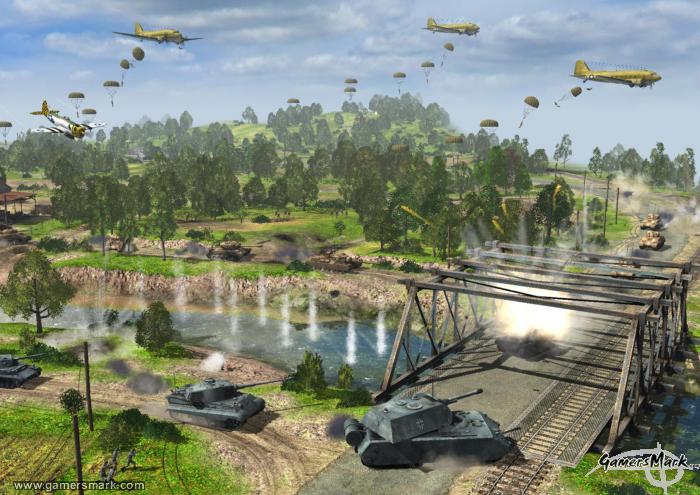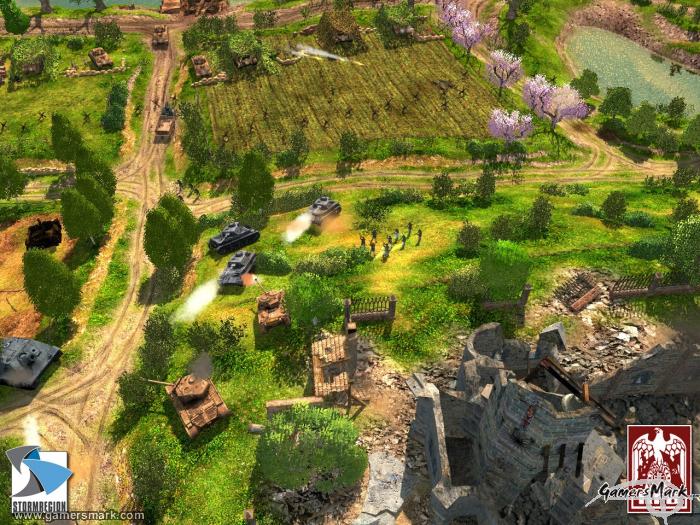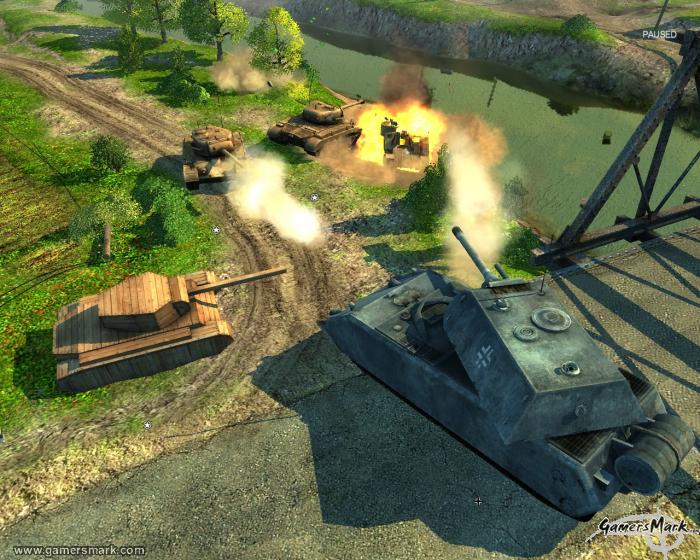Developer: Stormregion / Publisher: Paradox Interactive || Overall: 7.0/10
It’s not often we see a World War II game that is something other than a first person shooter. Rush for Berlin, developed by Stormregion, is a real-time-strategy game that strives to be a historically accurate and realistic rendition of World War II. Unfortunately for Rush for Berlin, it falls short of being totally enjoyable. Rush for Berlin will not be a game that makes waves through the genre; the game fails to be worthwhile, not only because of the extremely weak gameplay in the single player mode, but the absolutely non-existent multiplayer community. It’s incredibly important for a real-time-strategy game to have these basic values in place, even before any kind of innovation is attempted.
The thoroughly unimpressive single player mode in Rush for Berlin struggles to prove any kind of worth whatsoever. Unfortunately for the actual real-time-strategy elements of the game, they are not utilized properly to show the strengths of what the gameplay actually has to offer. The single player mode is based on World War II, obviously, but there is absolutely no revolving story to connect any of the missions you go on. After a cheesy cutscene to set up a certain scenario, you’ll begin your mission with a set amount of units and go on your way doing what needs to be done. What needs to be done usually consists of killing your enemies until there are none left, or capturing certain points of interest. Each mission is like a snapshot of history, and you jump around from time period to time period.
What brings down the experience of the single player mode the most is that there is little to no traditional base vs. base gameplay. Most of the missions are what I like to call “limited force” missions – you’re given a set amount of units and you’re on your way. Occasionally you are able to capture a factory to create more units, but you’re not going to be building factories or barracks like in traditional RTS games. Any and all buildings or structures you own have to be captured and can be recaptured by the enemy if you let your guard down.
The multiplayer mode is by far the biggest disappointment in Rush for Berlin. I was disenchanted when I found absolutely no one on the servers. Since the game used Gamespy, it was very easy to log in, but that was where the pleasant experience stopped. To give you an idea of how desolate the multiplayer community is, there are more people playing the demo of the game than the full game. And since you have to have the same version as who you’re playing against, it doesn’t even let you play with the two or three people that just happen to be online, if you’re able to catch them on at the same time as you are. I almost downloaded the demo just so I could play against someone. This is a serious devaluation of the game, especially since the single player mode is less than fantastic. If you’re turned off by the single player mode you will have nowhere to go when it comes to playing Rush for Berlin, unless you know someone personally to play against.
As for the actual gameplay, it is particularly solid. The game itself puts more value into each of the units you have, as they are not usually available in huge quantities – you can’t just build any anytime you want, and when you can, it takes a long time to build a unit. It can take especially long sometimes since there is absolutely no resource gathering, you’ll have to wait even longer for the resource counter to get to the point you want it to get to before the unit begins to build.
Needless to say, base politics play a very small role in the game, and it comes down to actually managing your units and being strategic in how you use them. Because the game puts more stress on the units, you’ll actually be aware of when you lose a unit, as it could make or break your push through enemy territory. The flexibility of the gameplay is also shown by being able to take over enemy vehicles (provided their occupants are no more) and use them for your purposes. Many of the blown out buildings in the game can also be used for your tactical advantage by making your infantry go inside them so they are able to shoot at whoever comes by.
By far the most impressive aspect of Rush for Berlin are the graphics. The maps themselves are enormously detailed – urban areas really show the best of what Rush for Berlin has to offer in this aspect. All the units look about as realistic as they can be –vehicles more so than humans. Everything looks incredibly akin to what it would have looked like in World War II, which should be applauded. There is also a 3D camera, so you can get all sides of the action. Unfortunately, they assigned the scroll wheel click to changing the camera rather than the right click, which can make it difficult to be as precise as you might want to be.
Sound effects and music are another couple strong points, but the voice acting is awful. The sound effects are cool, and they really help in making you feel like you’re in the middle of a battlefield. The music is empowering as well, and usually has a “march to war” feeling attached – possibly offering motivation to do what you need to do. Voice acting, however, is on the completely different side of the spectrum. The actors sound like Europeans trying to imitate an American accent, which end up sounding like they’re a bunch of pricks at the gym with surly voices – it doesn’t really cut it for what the game is trying to accomplish.
Rush for Berlin ends up being just another lackluster World War II game. Perhaps if the same gameplay mechanics were exploited better, and there were a multiplayer community to interact with, Rush for Berlin would have been a solid game, but unfortunately that was not what came to fruition.



